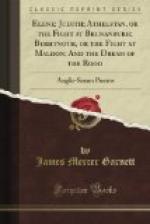III. The ATHELSTAN, or Fight at Brunanburh, is found in four manuscripts of the “Anglo-Saxon Chronicle” and in Wheloc’s edition (1643), printed from a MS. that was burnt in the unfortunate fire among the Cottonian manuscripts (1731). It is entered under the year 937 in all but one MS., where it occurs under 938. The poem gives a brief, but graphic, description of the fight between King Athelstan and his brother Edmund on the one side, and Constantine and his Scots aided by Anlaf and his Danes, or Northmen, on the other, in which fight the Saxons were completely victorious. The poem will be found in all editions of the “Anglo-Saxon Chronicle” from Wheloc to Earle (1865), and has been repeatedly reprinted, its brevity causing it to be often included as a specimen of Old English, but it is omitted in Sweet’s Reader. A Bibliography will be found in Wuelker’s Grundriss (p. 339 ff.). To the English translations there mentioned,—which include a poetical one by Lord Tennyson, after a prose translation by his son in the Contemporary Review for November, 1876,—may be added the prose translation by Kennedy in ten Brink (p. 91) and the rhythmical one by Professor Morley in his “English Writers” (II. 316-17). ten Brink thinks that the poem was not written by an eye-witness, and says (p. 92): “The poem lacks the epic perception and direct power of the folk-song as well as invention. The patriotic enthusiasm, however, upon which it is borne, the lyrical strain which pervades it, yield their true effect. The rich resources derived from the national epos are here happily utilised, and the pure versification and brilliant style of the whole stir our admiration.” It well serves to diversify and enliven the usually dry annals of the “Anglo-Saxon Chronicle,” and cannot be spared in the great dearth of poetry of this period.
IV. The BYRHTNOTH, or Fight at Maldon, relates in vigorous verse the contest between the Saxons, led by the Ealdorman Byrhtnoth, and the Danes at the river Panta, near Maldon in Essex, in which the Danes were victorious and Byrhtnoth was slain. The incident is mentioned in four manuscripts of the “Anglo-Saxon Chronicle” under the year 991, but one gives it under 993. The MS. in which the poem was contained was unfortunately burnt in the great fire above-mentioned (1731); but Thomas Hearne, the antiquary, had fortunately printed it, as prose, in his edition, of the Chronicle of John of Glastonbury (1726); hence this is now our sole authority for the text, which is defective at both the beginning and the end. The poem has been highly esteemed by scholars, and is a very valuable relic of late tenth century literature. It has been often reprinted, and translated several times in whole or in part. Grein does not translate either the ATHELSTAN or the BYRHTNOTH. Koerner translates it in full, and so does Zernial in his Program “Das Lied von Byrhtnoth’s Fall” (1882). This monograph contains the fullest study of the poem that has been made. It is translated




